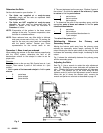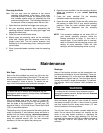
8 684025
Electrical Grounding
WARNING
4.
Spray gun or dispensing valve:
Obtain grounding
throu
g
h connection to a properly
g
rounded fluid hose
and pump.
FIRE AND EXPLOSION HAZARD
Static electricity is created by the hi
g
h velocity
flow of fluid throu
g
h the pump and hose. If your
system is not properly
g
rounded, sparkin
g
may
occur and the system may become hazardous.
To reduce the risk of static sparkin
g
which can
result in a fire or explosion and cause serious
injury, follow these recommendations for
providin
g
electrical continuity throu
g
hout your
system.
Also, read the WARNING section, FIRE AND
EXPLOSION HAZARD on page 4.
5.
Fluid supply container:
according to your local code.
6.
Object being sprayed:
according to local code.
7.
All solvent pails
used when flushing, according to local
code.
Use only metal pails
which are conductive,
placed on a positively
g
rounded surface. Do not place
the pail on a non-conductive surface, such as paper or
cardboard, which interrupts the grounding continuity.
8.
To maintain grounding continuity when flushing or
relieving pressure,
always hold a metal part of the gun
or dispensin
g
valve firmly to the side of a
g
rounded
metal pail, then trigger the gun.
1.
Pump:
Loosen the grounding lug locknut (A) and
washer. Insert one end of a 12
g
a (1.5 m
2
) minimum
g
round wire (B) into the slot in the lu
g
(C). Ti
g
hten the
locknut securely. See Fi
g
. 3. Connect the other end of
the
g
round wire to a true earth
g
round. Order a
Groundin
g
Clamp, P/N 103538, and a Groundin
g
Wire,
P/N 208950, (25 feet (7.6 m) long, 12 ga.).
2.
Air and fluid hoses:
Use only electrically conductive
hoses with a maximum of 500 feet (150 m) combined
hose length to ensure grounding continuity.
3.
Air compressor:
follow the air compressor
manufacturer’s recommendations
0720


















